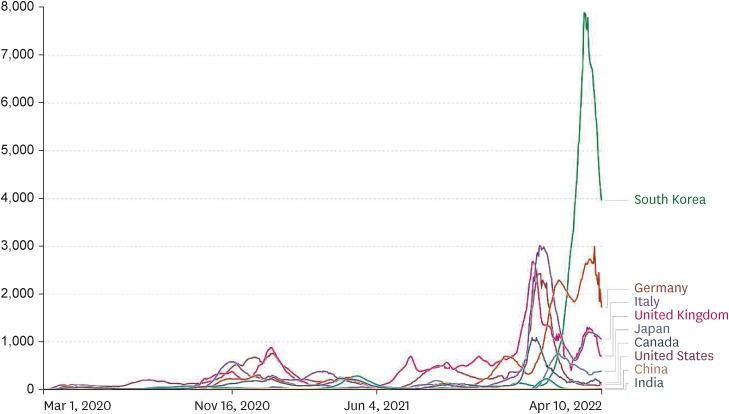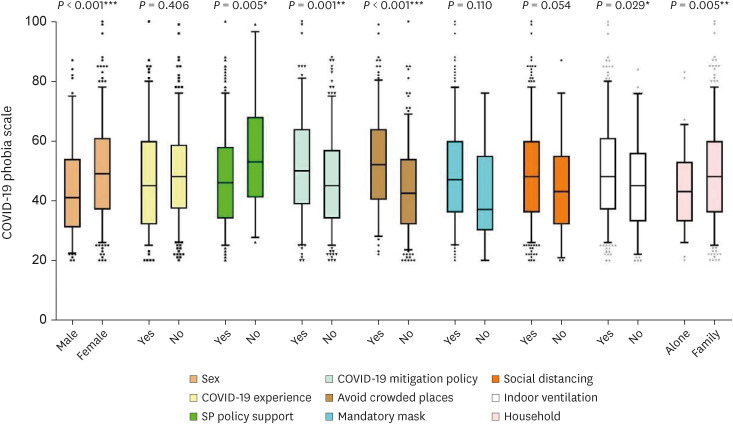J Korean Med Sci.
2023 Feb;38(7):e52. 10.3346/jkms.2023.38.e52.
Assessing the Fear Factor of Coronavirus Disease 2019 (COVID-19) in Korea Using the COVID-19 Phobia Scale: A Cross-Sectional Study
- Affiliations
-
- 1Yonsei Global Health Center, Yonsei University, Wonju, Korea
- 2Department of Health Administration, College of Software and Digital Healthcare Convergence, Yonsei University, Wonju, Korea
- 3Department of Health and Welfare, Pai Chai University, Daejeon, Korea
- 4Department of Health Management, Jeonju University, Jeonju, Korea
- 5Department of Healthcare Administration, Kosin University, Busan, Korea
- KMID: 2539537
- DOI: http://doi.org/10.3346/jkms.2023.38.e52
Abstract
- Background
A study on coronavirus disease 2019 (COVID-19) phobia among students revealed that fear of contracting COVID-19 was associated with commuting to school and spending time with others at school. Therefore, it is the need-of-the-hour for the Korean government to identify factors affecting COVID-19 phobia among university students and to consider these factors while framing the policy direction for the process of returning to normalcy in university education. Consequently, we aimed to identify the current state of COVID-19 phobia among Korean undergraduate and graduate students and the factors affecting COVID-19 phobia.
Methods
This cross-sectional survey was conducted to identify the factors affecting COVID-19 phobia among Korean undergraduate and graduate students. The survey collected 460 responses from April 5 to April 16, 2022. The questionnaire was developed based on the COVID-19 Phobia Scale (C19P-S). Multiple linear regression was performed on the C19P-S scores using five models with the following dependent variables: Model 1, total C19P-S score; Model 2, psychological subscale score; Model 3, psychosomatic subscale score; Model 4, social subscale score; and Model 5, economic subscale score. The fit of these five models was established, and a P-value of less than 0.05 (F test) was considered statistically significant.
Results
An analysis of the factors affecting the total C19P-S score led to the following findings: women significantly outscored men (difference: 4.826 points, P = 0.003); the group that favored the government’s COVID-19 mitigation policy scored significantly lower than those who did not favor it (difference: 3.161 points, P = 0.037); the group that avoided crowded places scored significantly higher than the group that did not avoid crowded places (difference: 7.200 points, P < 0.001); and those living with family/friends scored significantly higher than those in other living situations (difference: 4.606 points, P = 0.021). Those in favor of the COVID-19 mitigation policy had significantly lower psychological fear than those who were against it (difference: -1.686 points, P = 0.004). Psychological fear was also significantly higher for those who avoided crowded places compared to those who did not difference: 2.641 points, P < 0.001). Fear was significantly higher in people cohabitating than those living alone (difference: 1.543 points, P= 0.043).
Conclusion
The Korean government, in their pursuit of a policy that eases COVID-19-related restrictions, will also have to spare no efforts in providing correct information to prevent the escalation of COVID-19 phobia among people with a high fear of contracting the disease. This should be done through trustworthy information sources, such as the media, public agencies, and COVID-19 professionals.
Keyword
Figure
Reference
-
1. World Health Organization. Coronavirus disease (COVID-19): Situation report, 171. Updated 2020. Accessed July 12, 2022. https://apps.who.int/iris/handle/10665/333151 .2. World Health Organization. Coronavirus disease (COVID-19): Situation report, 203. Updated 2020. Accessed July 1, 2022. https://apps.who.int/iris/handle/10665/333835 .3. Jung SJ, Jun JY. Mental health and psychological intervention amid COVID-19 outbreak: perspectives from South Korea. Yonsei Med J. 2020; 61(4):271–272. PMID: 32233168.
Article4. Kim SW, Su KP. Using psychoneuroimmunity against COVID-19. Brain Behav Immun. 2020; 87:4–5. PMID: 32234338.
Article5. Kim SY, Yoo DM, Min C, Choi HG. Assessment of the difference in depressive symptoms of the Korean adult population before and during the COVID-19 pandemic using a community health survey. J Affect Disord. 2022; 300:130–136. PMID: 34965394.
Article6. Bahk YC, Park K, Kim N, Lee J, Cho S, Jang J, et al. Psychological impact of COVID-19 in South Korea: a preliminary study. Korean J Clin Psychol. 2020; 39(4):355–367.
Article7. Czeisler MÉ, Lane RI, Petrosky E, Wiley JF, Christensen A, Njai R, et al. Mental health, substance use, and suicidal ideation during the COVID-19 pandemic—United States, June 24–30, 2020. MMWR Morb Mortal Wkly Rep. 2020; 69(32):1049–1057. PMID: 32790653.
Article8. Cheval B, Sivaramakrishnan H, Maltagliati S, Fessler L, Forestier C, Sarrazin P, et al. Relationships between changes in self-reported physical activity, sedentary behaviour and health during the coronavirus (COVID-19) pandemic in France and Switzerland. J Sports Sci. 2021; 39(6):699–704. PMID: 33118469.
Article9. Mun H, So ES. Changes in physical activity, healthy diet, and sleeping time during the COVID-19 pandemic in South Korea. Nutrients. 2022; 14(5):960. PMID: 35267935.
Article10. Almuzaini Y, Mushi A, Aburas A, Yassin Y, Alamri F, Alahmari A, et al. Risk communication effectiveness during COVID-19 pandemic among general population in Saudi Arabia. Risk Manag Healthc Policy. 2021; 14:779–790. PMID: 33658873.
Article11. Renström EA, Bäck H. Emotions during the Covid-19 pandemic: fear, anxiety, and anger as mediators between threats and policy support and political actions. J Appl Soc Psychol. 2021; 51(8):861–877. PMID: 34511637.
Article12. Sahoo S, Rani S, Parveen S, Pal Singh A, Mehra A, Chakrabarti S, et al. Self-harm and COVID-19 pandemic: an emerging concern - a report of 2 cases from India. Asian J Psychiatr. 2020; 51:102104. PMID: 32325391.
Article13. Zhang Y, Tambo E, Djuikoue IC, Tazemda GK, Fotsing MF, Zhou XN. Early stage risk communication and community engagement (RCCE) strategies and measures against the coronavirus disease 2019 (COVID-19) pandemic crisis. Glob Health J. 2021; 5(1):44–50. PMID: 33850632.
Article14. Yoo KJ, Kwon S, Choi Y, Bishai DM. Systematic assessment of South Korea’s capabilities to control COVID-19. Health Policy. 2021; 125(5):568–576. PMID: 33692005.
Article15. Lee HJ. Experts warn of new COVID-19 wave this fall. The Korean Times. 2022. 04. 21. Accessed August 21, 2022. https://www.koreatimes.co.kr/www/nation/2023/01/113_327764.html .16. Ju YJ, Kim W, Lee SY. Perceived social support and depressive symptoms during the COVID-19 pandemic: a nationally-representative study. Int J Soc Psychiatry. 2022.
Article17. Al Mamun F, Hosen I, Misti JM, Kaggwa MM, Mamun MA. Mental disorders of Bangladeshi students during the COVID-19 pandemic: a systematic review. Psychol Res Behav Manag. 2021; 14:645–654. PMID: 34104010.
Article18. Arpaci I, Karataş K, Baloğlu M. The development and initial tests for the psychometric properties of the COVID-19 Phobia Scale (C19P-S). Pers Individ Dif. 2020; 164:110108. PMID: 32394993.19. Bilgiç Ş, Baloğlu M, Tokalilar S. Adapting and validating the coronavirus-19 phobia scale (C19P-S) in Korea. Death Stud. 2022; 46(3):590–594. PMID: 33999762.20. Seong M, Lee M, Kim I, Kang M. Validation of the Korean version of the COVID-19 phobia scale (K-C19PS). Int J Environ Res Public Health. 2021; 18(7):3747. PMID: 33916718.21. GallupKorea. Korea Gallup daily opinion. 2022. Accessed June 29, 2022. https://www.gallup.co.kr/gallupdb/reportContent.asp?seqNo=1291 .22. Wang C, Pan R, Wan X, Tan Y, Xu L, Ho CS, et al. Immediate psychological responses and associated factors during the initial stage of the 2019 coronavirus disease (COVID-19) epidemic among the general population in China. Int J Environ Res Public Health. 2020; 17(5):1729. PMID: 32155789.23. Korea Disease Control and Prevention Agency. Regional health statistics summary. 266. Updated 2022. Accessed August 9, 2022. https://chs.kdca.go.kr/chs/main.do .24. Martins-Filho PR. Relationship between population density and COVID-19 incidence and mortality estimates: a county-level analysis. J Infect Public Health. 2021; 14(8):1087–1088. PMID: 34245973.
Article25. Harper CA, Satchell LP, Fido D, Latzman RD. Functional fear predicts public health compliance in the COVID-19 pandemic. Int J Ment Health Addict. 2021; 19(5):1875–1888. PMID: 32346359.26. Vann RJ, Tanner EC, Kizilova E. Perceived access, fear, and preventative behavior: key relationships for positive outcomes during the COVID-19 health crisis. J Consum Aff. 2022; 56(1):141–157. PMID: 35603321.27. Doshi D, Karunakar P, Sukhabogi JR, Prasanna JS, Mahajan SV. Assessing coronavirus fear in Indian population using the fear of COVID-19 scale. Int J Ment Health Addict. 2021; 19(6):2383–2391. PMID: 32837422.28. Weiss BD, Paasche-Orlow MK. Disparities in adherence to COVID-19 public health recommendations. Health Lit Res Pract. 2020; 4(3):e171–e173. PMID: 32926173.29. Raghupathi V, Raghupathi W. The influence of education on health: an empirical assessment of OECD countries for the period 1995-2015. Arch Public Health. 2020; 78(1):20. PMID: 32280462.30. Im J, Kim J, Choeh JY. COVID-19: were public health interventions and the disclosure of patients’ contact history effective in upholding social distancing? evidence from South Korea. J Multidiscip Healthc. 2021; 14:705–712. PMID: 33790569.31. World Health Organization. Statement on the eleventh meeting of the International Health Regulations (2005) Emergency Committee regarding the coronavirus disease (COVID-19) pandemic. 2022. 04. 11.32. Sleigh J, Amann J, Schneider M, Vayena E. Qualitative analysis of visual risk communication on twitter during the Covid-19 pandemic. BMC Public Health. 2021; 21(1):810. PMID: 33906626.
- Full Text Links
- Actions
-
Cited
- CITED
-
- Close
- Share
- Similar articles
-
- Factors Affecting Fear of COVID-19 Infection in Healthcare Workers in COVID-19 Dedicated Teams: Focus on Professional Quality of Life
- Factors Associated With Fear of Coronavirus Disease 2019 Stigmatization in the Elderly
- Assessment and Management of Dysphagia during the COVID-19 Pandemic
- The Effect of Fear of COVID-19 Infection and Anxiety on Loneliness: Moderated Mediation Effects of Gratitude
- COVID-19 from the Perspective of a Gastroenterologist



